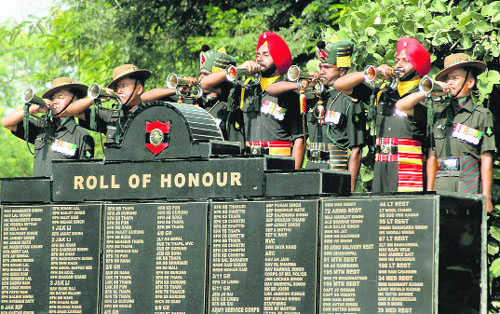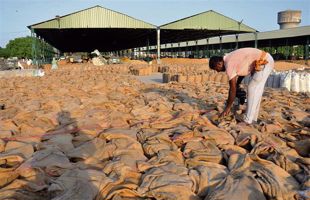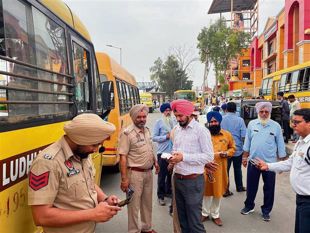
File photo: Manoj Mahajan
Dinesh Kumar
Is an army only meant to fight a war? So it seems, according to Defence Minister Manohar Parrikar, who earlier this week observed that the Indian Army's importance has diminished because the country has not gone to battle in the past four to five decades. Parrikar's facts are incorrect; his perception and understanding of the purpose of an army is misplaced.
The reason why a nation, especially democracies, maintain an army is to defend its territorial integrity in the event of an attack from an adversary. Armies of civilised nations, such as India, do not initiate wars or harbour expansionist designs. So, if a war does not occur, should a nation, particularly its leaders, pin the Army's state of neglect on its not having the opportunity of fighting a war? Conversely, should a country be in a constant state of war in order to ensure the importance of its army?
“The supreme art of war”, argued well-known Chinese general and military strategist Sun Tzu some 2,500 years ago, “is to subdue the enemy without fighting”. “Supreme excellence”, he said, “consists of breaking the enemy's resistance without fighting”. Around the same time, Chanakya, an indigenously produced master of statecraft, spoke for the need for a king's (read state's) superiority in its military and economic might. His classification of war of three types — open, concealed (guerilla) and silent (espionage) — continues to apply 2,290 years after he died. In more recent times, 19th century Prussian general and military strategist Carl Philipp Gottfried von Clausewitz termed war as simply “a continuation of political intercourse by other means”. In other words, war isn't an isolated act; neither is its result final.
In modern times an army is more about building capabilities with the purpose of deterrence than to actually engage in war. Wisdom lies in preventing wars and ensuring peace. Besides, wars have become far more tougher to fight and even more difficult to win with the kind of sophisticated military technology that is now available. The scope for destruction is incredibly immense and its adverse impact on the economy horrendous. And yet the recent US engagement in Iraq and Afghanistan (and earlier on in Vietnam) has revealed that sophisticated military technology and might can be of limited match against low- intensity guerilla warfare. In the 1980s, the Indian Army experienced this in Sri Lanka and the mighty former Soviet Union in Afghanistan. History, in fact, is replete with such examples.
As Defence Minister, Parrikar should be aware that the BJP-led NDA-I, under Atal Bihari Vajpayee, had fought a two-month-long war in the daunting high-altitude Kargil region of Ladakh in the state of Jammu and Kashmir.
Even though it was a limited war, aimed at reclaiming territory that had been surreptitiously occupied by the Pakistani Army, all three services had been mobilised during the war. Infantry battalions fought pitched uphill battles in hostile terrain even as the artillery and the Indian Air Force, respectively, rained tens of thousands of shells and hundreds of bombs. The war resulted in the death of 524 soldiers (including six airmen) and 1,363 more wounded. Two aircraft, (a MiG-21 fighter and a Mi-17 helicopter), were shot down.
That was an “open” war to use Chanakya's terminology. What about the “concealed” war that Chanakya refers to? The Indian Army has lost more soldiers fighting insurgency than it has in “open” wars. For example, between 2001 and 2014 (14 years alone), the Army lost 2,387 soldiers. This is double the number the Army lost during the year-long Kashmir war of 1947-48, when it lost 1,103 soldiers. The total figure of the Indian Army’s ‘peace time’ casualties is much higher keeping in view its engagements in operations other than war since Independence. The Army was first deployed in counter-insurgency operations in the 1950s starting with Nagaland which later expanded to Mizoram, Manipur, Assam and Meghalaya; then in J&K starting from December 1989; on the Siachen glacier starting from April 1984; in Sri Lanka (1987-89) and in internal security military operations in Punjab — Operation Bluestar (June 1984) and Operation Rakshak (1991-92).
Even though it is the world's third largest, the Indian Army is severely overstretched. This understaffed and underarmed Army suffers a perennial shortage of officers (9,642) and soldiers (24,356) as does also the Navy and Air Force. The Army’s most modern artillery gun is three-decade old. It suffers a shortage of basic items such as bullet-proof vests and has rifles of questionable quality. But its biggest challenge is, and will continue to be, the quality of its leadership.
Senior officers have been engaged in rivalry that has not helped the Army's image. Corruption, both financial and professional by some officers, has sullied its image as have incidents of indiscipline.
India's defence budget maybe less than 2 per cent of the GDP and compares poorly to China ($145 billion), but the money involved stands at a staggering total of Rs 2,46,727 crore ($40 billion).
In fact, the defence budget exceeds Rs 3 lakh crore, after adding Rs 62,852 crore for defence pensions and civil expenditure of the Ministry of Defence. And yet it isn't enough.
The Indian armed forces are badly in need for modernisation requiring billions of dollars to keep pace with modern military technology and to build capabilities for a war that is increasingly unlikely.
It is, to quote Joseph Heller, a proverbial Catch-22 situation where the requirement of expenditure is huge whereas the probability of war is low in an otherwise complicated security situation in a region where India finds itself hemmed in by two neigbours, both nuclear weapon states, and with whom it has a long legacy of disputed land borders.
Finally, Parrikar and his government at the Centre may like to introspect why the BJP, which considers itself to be the repository of all patriotism, is unable to ensure that states ruled by them have been unable to attend to the civilian demands of retired and serving soldiers.
Just as “war is too important a matter to be entrusted to military men,” as French statesman Georges Benjamin Clemenceau famously remarked, defence also is too critical a matter to be left to ignorant politicians. There is, as Clausewitz advises, a need for an overlap between the civilian and the military leadership, where both sides understand each other's functioning.



























